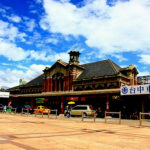Taichung Old Train Station
In the early 20th century Taichung was a sleepy backwater with big plans. In 1905, the Japanese built the first station on the site with the first trains arriving in 1908. The rail link proved crucial to the city’s development and island as a whole. The influx of raw materials and manpower built many of the city’s landmarks, and Taichung became a major power center.
 However the first station’s wooden construction was a simple wooden affair ill suited to the needs of a burgeoning population and a second brick building was built by 1917. The new station employed a mix of Victorian and European styles called Free Classical Style designed to show progress and vitality, a theme popular in Japan at the time. It was the new hub to a bustling city and its design conveyed a growing strength. A striking clock tower, high ceilings and windows give the lobby and waiting rooms an airy feel and was a striking symbol to new arrivals.
However the first station’s wooden construction was a simple wooden affair ill suited to the needs of a burgeoning population and a second brick building was built by 1917. The new station employed a mix of Victorian and European styles called Free Classical Style designed to show progress and vitality, a theme popular in Japan at the time. It was the new hub to a bustling city and its design conveyed a growing strength. A striking clock tower, high ceilings and windows give the lobby and waiting rooms an airy feel and was a striking symbol to new arrivals.
For over a hundred years Taichung train station has been an essential part of the city and a familiar landmark to millions of residents. When a new third station was announced in 1995, an outpouring of support quickly ensured the old station’s future as a National Tier 2 historic site. The station that once helped birth a city will remain a source of pride, and a rare historic landmark as the city reinvents itself yet again in the 21st century.
A New Beginning
In October 2016, Taichung’s station’s latest incarnation opened to the public. Taichung’s railway lines are switching to an elevated system in preparation for a soon-to-be-operational city-wide metro. The new station is one of dozens of elevated stations slated to open throughout the city. The interior of the new structure is 30 times bigger with 5 lines as opposed to 3 lines in the old one. The new building is further part of a broader effort to redevelop central Taichung which has stagnated over the past 30 years. With some of the load taken off, Taichung’s old station will become a railway museum with an multi-use public space on the ground floor.
Hidden Details
The exterior of the building may be a striking mix of columns, beams, arches and pediments. However, look closely and you’ll notice several decorative efforts by the colonial government to win over the local populace. These include four kinds of native fruit symbolic of Taiwan on the clock tower and stucco artwork facing the station,namely pineapples, pomegranates, wax apples and bananas. You can also see local flora adorning the wide tops of columns separating the lobby and waiting areas. Other hidden features are more practical. To the left and right of the main entrance are original horse troughs that are today seats for unknowing passengers. Original wooden beams from the first station can also be seen supporting the front veranda of the station in front of the entrance.
What to See
While the old station’s renovation is not fully complete, the structure itself is an excellent example of colonial Taiwanese architecture. There’s also a very handy gift shop for souvenirs and postcards from Taichung inside the lobby area.
References
http://www.taiwanfun.com/central/taichung/articles/1507/1507TCTM1.htm
http://www.taipeitimes.com/News/feat/archives/2017/01/11/2003662879/
http://www.waymarking.com/waymarks/WM8YEZ_Taichung_Railway_Station_Taiwan
Photo Credit
Cover Photo by Ltdccba (Own work) [CC BY-SA 3.0], via Wikimedia Commons
Insert Photo by Beefly via Flickr